
By Mx Kris Vyas-Myall
So, Britain has a new Prime Minister. Edward “Ted” Heath (not the conductor). He couldn’t be more different from the last Conservative Prime Minister, Sir Alec Douglas-Hume. Heath is the son of a carpenter and a chambermaid. He worked in banking, is unmarried and has a passion for sailing yachts and playing the organ.
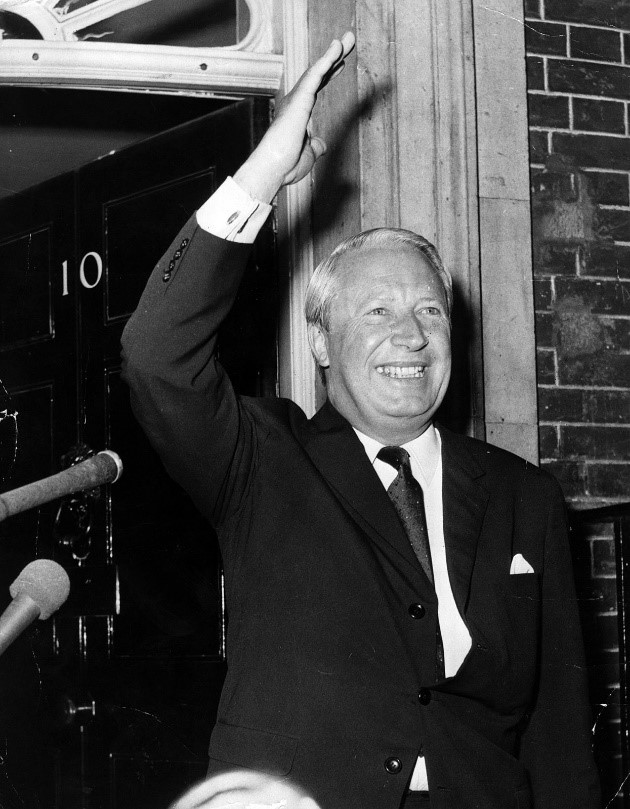
Edward Heath moves into his new house
One of the first orders of business for him, as it would have been for Wilson, is a meeting with The Six, AKA the leaders of the six members of the European Economic Community, in order to discuss the possibility of Britain’s entry into the Common Market. This is a particular passion project for Heath, who is a known Francophile and whose previous negotiations in this era led to the press declaring him “Lord Heath of Brussels”.
In fact, Britain is not the only country trying to join. Ireland, Denmark and Sweden have all made applications to join and these have been going on for some time. There is however a reason this year will be different. That is the absence of Charles de Gaulle. Central to French politics over the last decade, he used his power to oppose any enlargement of the EEC.
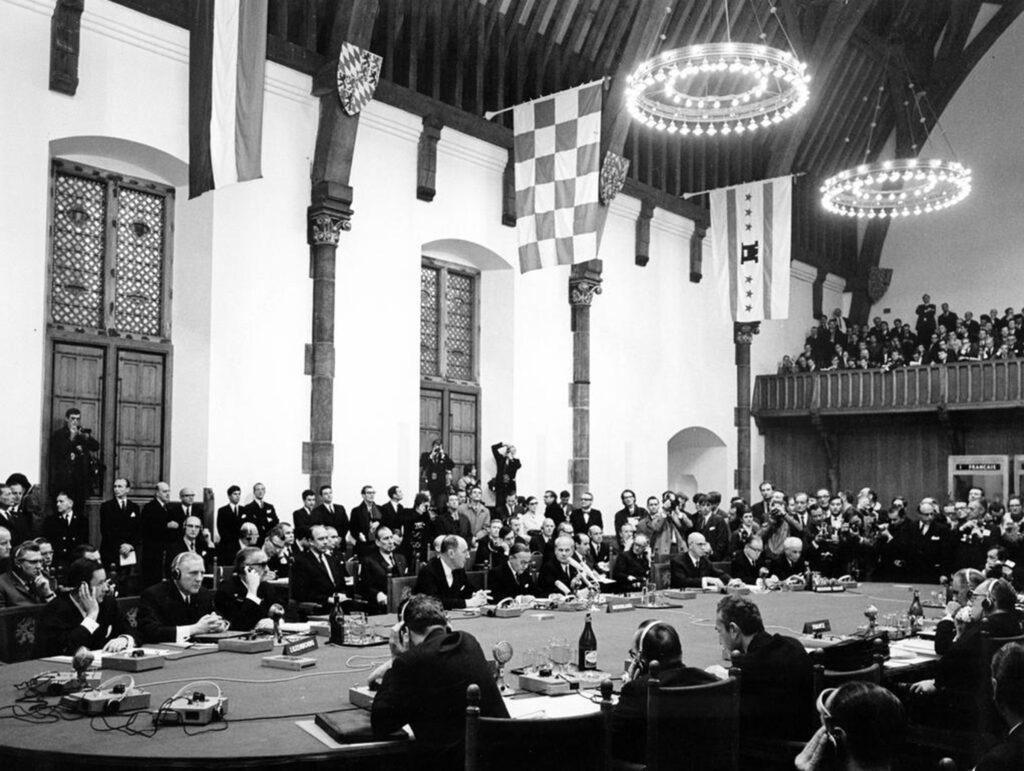
The December Hague Summit
With his retirement and replacement by Pompidou, who has switched his approach to appeal to more liberal voters, the calculus has changed. Following the Hague Summit in December negotiations have officially begun again in Luxembourg. There are a number of points that are still subject to negotiation, but things appear to be moving forward.
In the pages of Vision of Tomorrow, Europhilia is on display and it is time for me to negotiate my way through six stories: some about major nations, some involving small grand duchies, but all will be covered with sufficient weight:
Vision of Tomorrow #11
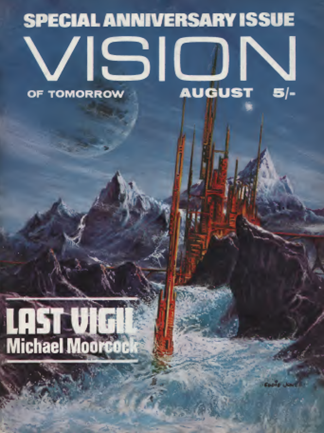
Cover by Eddie Jones
Editorial: Dedication
Philip Harbottle dedicates this anniversary issue to the Heidelberg World Science Fiction convention, noting the growing importance of European science fiction. I definitely do not disagree with this point.
Memories of the Future: Writers vs. Hollywood by John Baxter

Photograph from 2001: A Space Odyssey
This part covers the post-war boom in SF cinema (and touching on British TV serials) from Destination Moon (1950) to The Illustrated Man (1969), with a particular focus on the relationship between Hollywood directors and SF authors.
This is a much more considered discussion than we generally see in SF magazines, who usually seem to be snobbish about anything outside of prose fiction. Baxter still holds that they do not capture the feel of the original, but he points out that is for the same reason as no one writes a short story capturing classical music. The medium is different and you need to assess them as such, so he instead focusses on their value in themselves.
Five Stars
Culpable in Glass by Kenneth Bulmer
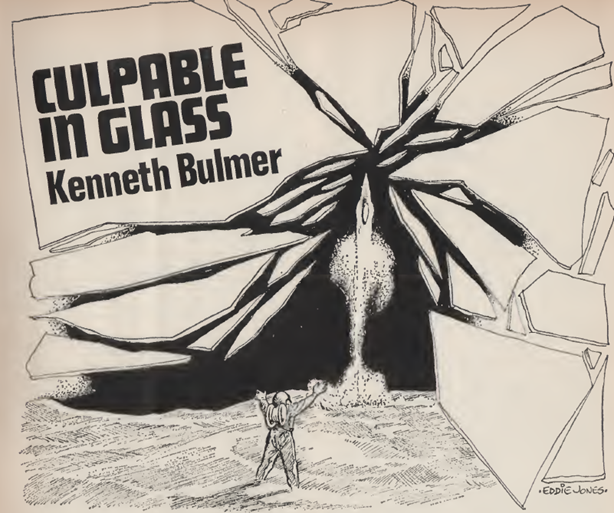
Illustration by Eddie Jones
On the second landing on Mars, two men had gone down to the surface, Charlie Garrett and Vance Mc’Neill. However, a fault meant the landing craft had only been able to carry one of them back up to orbit. In a game of Scissors-Paper-Stone, Mc’Neill lost out and died on the red planet.
Several years later, Brooke is a widower who has taken on a job composing educational tapes. When he is commissioned to do one of the early Mars landings, he takes it upon himself to track down the reclusive Garrett and understand what it was like to have make such a decision. And, in doing so, possibly come to terms with the death of his wife Rosa.
This is more of the Ken Bulmer I was missing. Not that I would cite this as his best work, but he demonstrates his understanding of character well and his exploration of grief is interesting. It does feel a little muddled at times and could maybe have been a page longer, but I still enjoyed it.
A low Four Stars
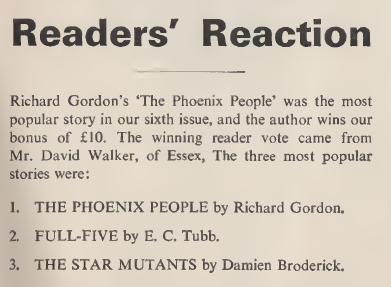
Ratings for Issue #6. Whilst I agree with Full-Five and Star Mutants, Phoenix People did not work for me. Would have chosen Brunner as my number 3 behind the other two.
Rule of the Brains by John Russell Fearn
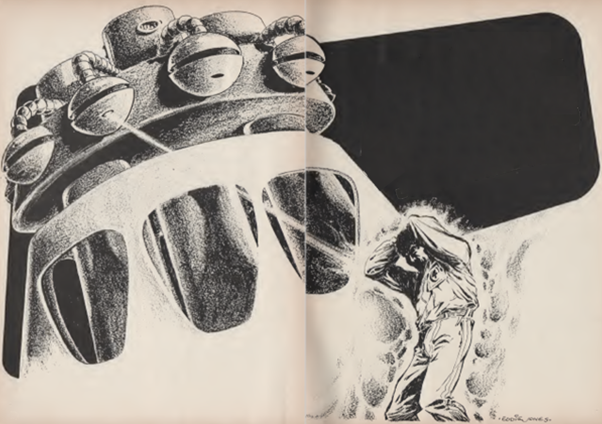
Illustration by Eddie Jones
For half-a-century, Major City has been a perfectly controlled environment, providing comfort and safety to all its workers. Chief Overseer Sherman Clarke, however, is not happy. He believes that, without struggle, civilization has become stagnant, and the worker's lot is not fair compared to that of the intelligentsia. To arbitrate this issue, the President orders the construction of an indestructible mechanical creature containing six worker brains and six intelligentsia brains.
When it comes online, The Arbiter finds itself in possession of long-distance mental powers and uses them to stop any who threaten its power or question its authority in all matters. The only possible hope is an experimental surgery to increase the human’s brain power by five times, where such an individual could battle The Arbiter on the mental plain.
This was originally scheduled to appear in the Post-War magazine Fantasy (see below) and has once again been provided to Vision by Walter Gillings, with permission of the Fearn estate. And, once again, this shows in the writing. Even in the late 40s this would have been on the old-fashioned side, sitting uncomfortably between Arthur C. Clarke, John Christopher and Eric Frank Russell. It is very much more what I would expect to see in 30s Thrilling Wonder. It also goes on far too long, by the eighth chapter I was having to really push myself to finish the whole thing.
One Star
The Impatient Dreamers: Pages in Waiting by Walter Gillings
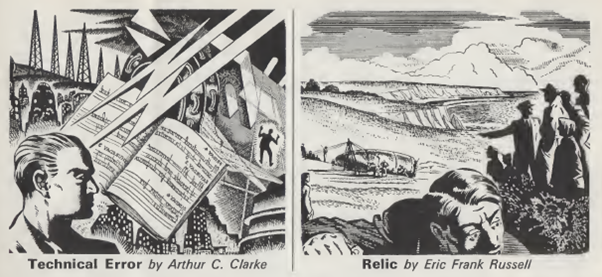
Stories from Gillings’ Fantasy. Illustrations by Powell
This covers the Post-War market for British SF, particularly focussed on Fantasy (which only lasted 3 issues due to paper rationing) but also covering hardback novels, SF horror titles such as Futuristic Tales and Gillings’ fanzine Fantasy Review.
Whilst it still contains interesting information, such as that many of the opening issues of Science Fantasy in 1950 were from the stories sold to Fantasy but not able to be published, it covers too many topics too briskly compared with other editions. Still, it is important that this is not ignored entirely, and I am glad he is keeping up with his pages of contents for these magazines, given these are rarely as well indexed as their American counterparts.
Four Stars
Spawn of Jupiter by E. C. Tubb
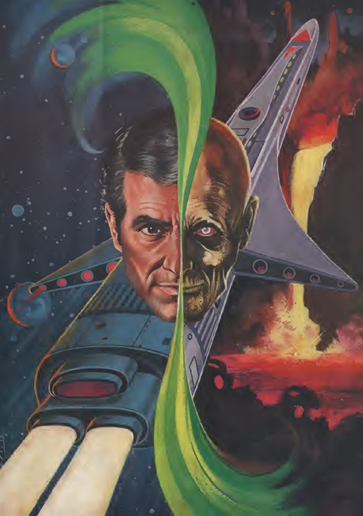
Special Colour Illustration by Stanley Pitt
Brad Durgan was once one of the best pilots around Jupiter, until he was dismissed for supposedly losing his nerve. After years of scraping out an existence on Ganymede, Sheila Moray brings him to her boss Creech to fly again on a unique mission.
The Archimedes was wrecked and sits on the solid core of Jupiter, with a year’s supply of shadeena crystals, enough to make them all incalculably rich. All Brad has to do is pilot a bucket boat down for the salvage. Of course, actually getting to the centre of the gas giant is not an easy matter, let alone returning.
There is a lot to love in this tale. First off, Tubb creates different worlds on each of Jupiter’s Moons, making it a filled in universe quickly. Secondly, even if archetypal, the characters feel fully alive. Most importantly, there is a constant sense of excitement which is sometimes all too absent from the harder side of SF.
I will give this a high Four Stars; Niven fans may put it higher.
Last Vigil by Michael Moorcock
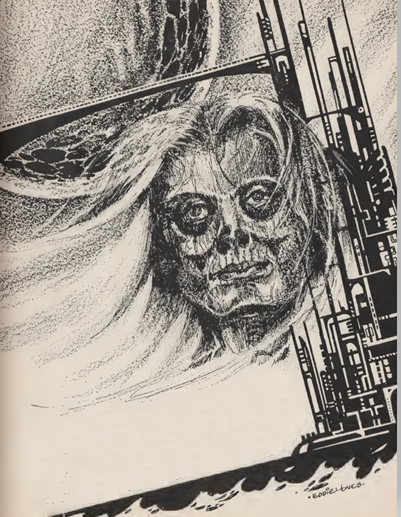
Illustration by Eddie Jones
In the far future, human scientists saw that the collapse of the galaxy was coming. On Tanet-tur-Taac, a planet at the edge of the galaxy, was built the city machine of Rion-va-mey, in an attempt to detach the planet from the galactic gravitation and to attempt to find humanity somewhere else to call home. The attempt failed.
Now the last two humans, Suron and Mis’rn, highly evolved hermaphrodites, await the inevitable end inside Rion. On the final day, however, Suron notices a movement on the planet’s surface. Going to investigate, he finds one of the supposedly extinct indigenous inhabitants of the planet: Mollei Coyshkaery. A member of this species humanity had attempted to destroy centuries ago is still living in the cave system beneath the planet.
This is a great piece from Michael Moorcock, here in more meditative mode than we have seen in some of his other recent pieces. It looks at the fruitlessness of existence but not in a nihilistic manner. Rather in an expansive beauty that suggests “even this too shall pass”.
Some may find the end heavy-handed, but it appealed to me.
Five Stars
Cold Crucible by Bob Shaw
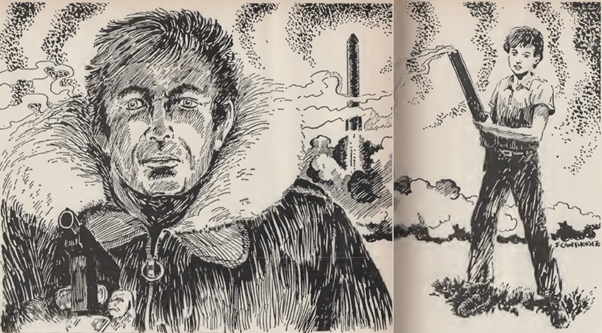
Illustration by James Cawthorn
A team of five agents are sent to track down an agent that can reveal details of the mission. However, one of the members, Dorian, keeps having flashbacks to his childhood when he thinks of the word “execution”, when he had to kill their cat Blackie for eating chickens.
Honestly, I found myself confused, even after reading through a couple of times, on exactly what happened here. It seems that something caused Dorian to become unstuck in time but what, why and exactly the point of it escaped me.
Two Stars
The Ultimate Weapon by Damien Broderick
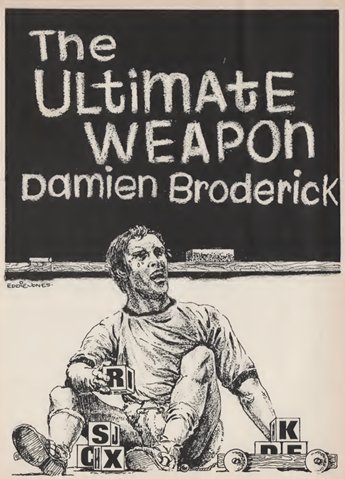
Illustration by Eddie Jones
Professor Hull was working on the Aegis Project when he fell sick. He is kept locked in a hospital in order to treat a case of food poisoning, but why would they keep him in such an advanced treatment facility for such a trifling thing?
An obvious mid-level story that is competently told.
Three Stars
Fantasy Review
Donald Malcolm reviews two works of critical analysis, Sam Moskowitz’s The Man Who Called Himself Poe and Alexei Panshin’s Heinlein in Dimension, and struggles with finding enough superlatives for them, whilst Kathryn Buckley is disappointed that the adventure and message sides of Bob Shaw’s Palace of Eternity do not gel.
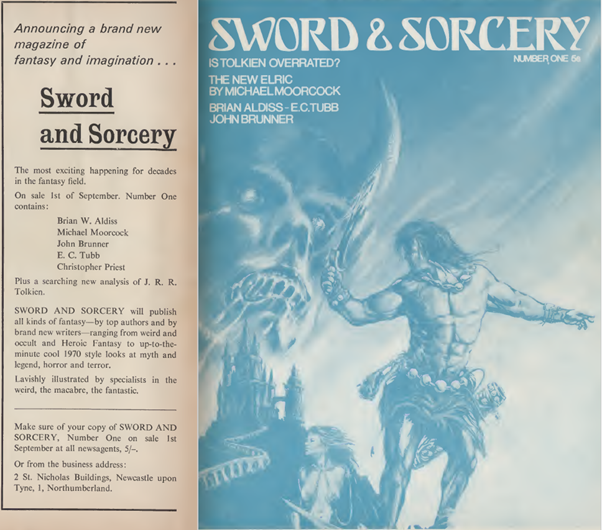
Ad for new magazine coming in September. Definitely looking forward to covering this one.
A Continent of Contrasts
Vision is a magazine of highs and lows, old and new styles, but perhaps together it makes an interesting community. Even in the case of the one star piece, it is hard to fault Harbottle for including unpublished stories by his favourite author within these pages now that he has the chance. There are rumours that there may be a new reprint magazine coming from the same company soon, so perhaps that will work as a good home for these in the future.
And, as I noticed above, it is soon going to be joined by a companion magazine of tales of fantasy. Maybe I will be reviewing at least ten stories every month as we expand like Europe. Here is to the EEC, our Expanded Epic Compendiums.

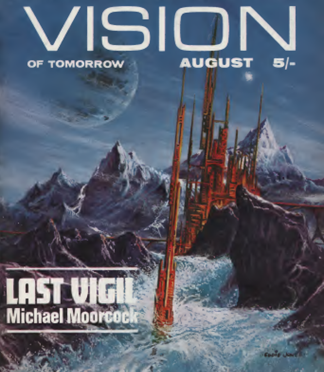


"Last Vigil" by Michael Moorcock sounds intriguing! Especially as I have not had the best luck with his fiction…
It does have the advantage of being very short, only 4 pages long.
If I was compare it stylistically and thematically to another work, I would say it has similarity to Greybeard by Brian Aldiss.